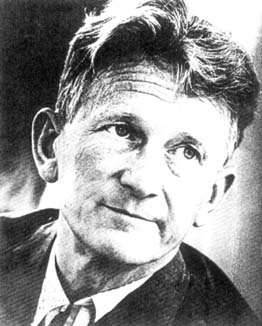
Atle Selberg
 المؤلف:
Biography in Encyclopaedia Britannica
المؤلف:
Biography in Encyclopaedia Britannica
 المصدر:
Biography in Encyclopaedia Britannica
المصدر:
Biography in Encyclopaedia Britannica
 الجزء والصفحة:
...
الجزء والصفحة:
...
 25-12-2017
25-12-2017
 710
710
Born: 14 June 1917 in Langesund, Norway
Died: 6 August 2007 in Princeton, New Jersey, USA

Atle Selberg's interest in mathematics began when he was a schoolboy. He read Ramanujan's collected papers and was not only greatly impressed by the mathematics he read but also he was intrigued by Ramanujan's personality which he described as having "the air of mystery". Inspired by reading about Ramanujan and reading his work, Selberg began to make his own mathematical explorations.
Another major influence on Selberg's mathematical development was a lecture by Hecke at the International Mathematical Conference in Oslo in 1936. Selberg undertook his doctoral research at the University of Oslo. He was appointed a research fellow in 1942, the year before the award of his doctorate. He remained in this post until 1947 when he married and went to the United States.
Selberg spent the academic year 1947-48 at the Institute for Advanced Study at Princeton. The following year he spent as associate professor of mathematics at Syracuse University, returning to the Institute for Advanced Study at Princeton in 1949 as a permanent member. In 1951 Selberg was promoted to professor at Princeton.
In 1950 Selberg was awarded a Fields Medal at the International Congress of Mathematicians at Harvard. The Fields Medal was awarded for his work on generalisations of the sieve methods of Viggo Brun, and for his major work on the zeros of the Riemann zeta function where he proved that a positive proportion of its zeros satisfy the Riemann hypothesis.
Selberg is also well known for his elementary proof of the prime number theorem, with a generalisation to prime numbers in an arbitrary arithmetic progression. The history of the prime number theorem is very interesting. The theorem stating:-
The number of primes ≤ n tends to ∞ as n/logen
was conjectured in the 18th century. Riemann came close to proving the result, but the theory of functions of a complex variable was not sufficiently developed to enable him to complete the proof. The necessary analytic tools were known by 1896 when Hadamard and de la Vallée Poussin independently proved the theorem using complex analysis. The successful proof of this result was seen as one of the greatest achievements of analytic number theory. In 1949 Selberg and Erdős found an elementary proof that makes no use of complex function theory. Subsequent events are not entirely clear but Selberg published two papers An elementary proof of the prime number theorem and An elementary proof of Dirichlet's theorem about primes in an arithmetic progression in volume 50 of the Annals of Mathematics. The following year he published An elementary proof of the prime number theorem for arithmetic progressions.
In [2] Bombieri explains the source of Selberg's number theory sieve and shows that the idea of Selberg's l method and of his l2 sieve has its origin in Selberg's work on the analytic theory of the Riemann zeta function. In this work Selberg also introduced so-called mollifiers by the l2method. Probably Selberg's best and most important work is his trace formula for SL2(R), which was done several years after the work for which he was awarded the Fields Medal. Selberg used his trace formula to prove that the "Selberg zeta function" of a Riemann surface satisfies an analogue of the Riemann hypothesis.
Among the many outstanding mathematical contributions Selberg has made, there is his work on:-
... the Rankin-Selberg method, the "mollifier" device in the theory of Riemann's zeta function with its deep applications to zeros on or near the critical line and with Selberg's sieve as a by-product, ... Selberg's trace formula, Selberg's zeta function, ... automorphic functions, Dirichlet series.
Selberg's collected papers were published in two volumes (1989, 1991). Matti Jutila, reviewing these, writes:-
The publication of the collected papers of Atle Selberg is most warmly welcomed by the mathematical community for several reasons. First of all, the author is a living classic who has profoundly influenced mathematics, especially analytic number theory in a broad sense, for about fifty years. Secondly, his papers up to 1947, which appeared mostly in Norwegian series or journals of limited distribution and partly even during World War II, are now at last easily accessible. And thirdly, a lot of highly interesting mathematics comes into daylight via the two volumes of Selberg's collected papers...
Selberg was one of the four editors of Axel Thue's Selected mathematical papers published in Oslo in 1977. In 1989 Selberg published Reflections around the Ramanujan centenary which is the text of a talk which he gave at the conclusion of the Ramanujan Centenary Conference in January 1988 at the Tata Institute in Bombay. This tribute to Ramanujan, on the 100th aniversary of his birth, shows the important influence that Ramanujan had in Selberg's mathematical development.
Selberg has received many distinctions for his work in addition to the Fields Medal. He has been elected to the Norwegian Academy of Sciences, the Royal Danish Academy of Sciences and the American Academy of Arts and Sciences.
- Biography in Encyclopaedia Britannica.
http://www.britannica.com/eb/article-9089363/Atle-Selberg
Articles:
- E Bombieri, Selberg's sieve and its applications, in Number theory, trace formulas and discrete groups, Oslo 1987 (Boston, MA, 1989), 29-48.
- D Bump, The Rankin-Selberg method : a survey, in Number theory, trace formulas and discrete groups, Oslo 1987 (Boston, MA, 1989), 49-109.
- Obituary of Paul Erdős, in The Times London, 25 Sept, 1996.
 الاكثر قراءة في 1915to1919
الاكثر قراءة في 1915to1919
 اخر الاخبار
اخر الاخبار
اخبار العتبة العباسية المقدسة


